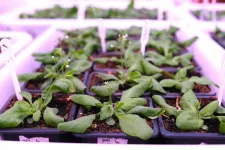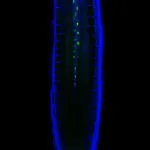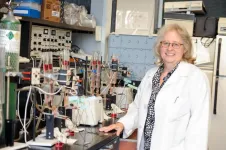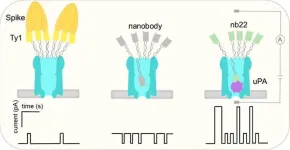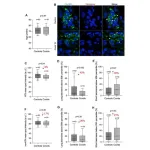Bellaterra (Barcelona), 16 June 2023
Researchers led by Núria Sánchez-Coll, CSIC researcher at the Centre for Research in Agricultural Genomics (CRAG), have characterized for the first time the function of AtMC3, a protein of the metacaspase family that is involved in drought tolerance in the model plant Arabidopsis thaliana.
The work, published in the New Phytologist journal in collaboration with several international research centers and universities, highlights the importance of vascular tissue for plants to cope with adverse conditions associated with water scarcity and osmotic stress.
Plants, as sessile organisms that cannot move like animals do, have evolved ways to endure water scarcity and periods of drought stress. However, increasing drought phenomena due to climate crisis pose a serious threat to agricultural productivity.
The importance of the plant vascular system
Plants rely on their vascular system connecting distantly separated organs to coordinate an efficient response to water deprivation at the organismal level. The primary components of vascular tissue are the xylem and phloem, tissues which transport fluids and nutrients internally. While the xylem transports water and nutrients upwards from roots to stems and leaves, phloem distributes the soluble organic compounds made in the leaves during photosynthesis to the rest of the plant.
In this work, CRAG researchers have found for the first time that the AtMC3 protein is exclusively located in the phloem. More specifically AtMC3 is found in a particular cell type of the vasculature, called companion cells which are metabolically supporting the main phloem transport cells (sieve elements), as observed by fluorescence microscopy images of the tip of the root.
When facing drought stress, several signalling molecules such as the plant stress hormone abscisic acid (ABA) are synthesized and transported to all plant tissues to trigger a series of physiological responses that will protect the plant. The present study describes that plants lacking AtMC3 are less sensitive to ABA and hence their ability to cope with drought stress is diminished. Moreover, altered levels of the AtMC3 protein lead to differential accumulation of stress-related proteins as well as defects in vascular development under stress conditions. This suggests that AtMC3 plays an important role for plants to respond adequately to osmotic stress and points out a possible new role for companion cells in stress sensing. Furthermore, phloem plasticity emerges as a useful tool to study and manipulate, in order to elucidate the plant responses to drought stress.
Tolerance to severe drought stress
When researchers increased the levels of AtMC3, plants increased survival rate and their ability to maintain their photosynthetic capacity in water scarcity conditions, indicating that AtMC3 alone can confer enhanced drought tolerance. More importantly, the altered levels of this protein did not cause any detrimental changes in plant growth, which «is a key finding to be able to fine-tune early drought responses at the whole plant level without affecting growth or yield in crops», states Eugenia Pitsili, first author of the study and former CRAG researcher, who is currently a postdoctoral researcher at VIB-UGent Center for Plant Systems Biology in Belgium.
This specific role of AtMC3 in drought stress aligns with the function of previously reported metacaspases, which have been linked to other stress responses such as those caused by pathogens or wounding.
This work opens the door to further studies to elucidate the exact mechanism of action of this protein to be able to understand the whole process in more depth and to evaluate whether it could have an application in crops.
Understanding the tissue specific mechanisms underlying the complex process of response to water scarcity is key to develop new tools to translate this knowledge into biotechnological and breeding solutions. These new tools will be crucial to improve crop performance in the field in a context of climate crisis.
Reference Article: Pitsili, E., et al. A phloem-localized Arabidopsis metacaspase (AtMC3) improves drought tolerance. New Phytol. (2023). https://doi.org/10.1111/nph.19022
About the authors and funding of the study: Research in the NSC-MV lab is funded by project PID2019-108595RB-I00 funded by MCIN/AEI/ 10.13039/501100011033, TED2021-131457B-I00 funded by MCIN/AEI/ 10.13039/501100011033 and by the “European Union NextGenerationEU/PRTR”, and and through the “Severo Ochoa Programme for Centres of Excellence in R&D” (SEV-2015-0533 and CEX2019-000902-S funded by MCIN/AEI/ 10.13039/501100011033). This work was also supported by the CERCA Programme/Generalitat de Catalunya. EP and JS-L were supported by fellowships BES-2016-077242 and BES-2017-080210, respectively, funded by MCIN/AEI/10.13039/501100011033 and by “ESF Investing in your future”. NR and RdP were supported by fellowships FPU2019-03778 and FPU2018-03285, respectively, funded by Ministerio de Universidades. The AR-V lab was funded by the Swiss National Foundation, Stavros-Niarchos/ETH-Foundation (EK) and a Swiss government fellowship (RRT). MJH and CD were supported by the University of Nottingham. The authors acknowledge support of the publication fee by the CSIC Open Access Publication Support Initiative through its Unit of Information Resources for Research (URICI).
About the Centre for Research in Agricultural Genomics (CRAG): CRAG is a centre that forms part of the CERCA system of research centres of the Government of Catalonia (Spain), and which was established as a partnership of four institutions: the Spanish National Research Council (CSIC), the Institute for Agri-Food Research and Technology (IRTA), the Autonomous University of Barcelona (UAB) and the University of Barcelona (UB). CRAG’s research spans from basic research in plant and farm animal molecular biology, to applications of molecular approaches for breeding of species important for agriculture and food production in close collaboration with industry. In 2020, CRAG was recognized for the second time as a "Severo Ochoa Centre of Excellence” by the Spanish Ministry of Economy and Competitiveness.
Images:
1_Arabidopsis-plant_CRAG.jpg: The model plant Arabidopsis thaliana used in the study (Credit: CRAG).
2_Arabidopsis-drought_CRAG.jpg: Example of one of the experiments, where several Arabidopsis thaliana plants have been grown in water scarcity conditions (Credit: CRAG).
3_Root-fluorescence_CRAG.png: Fluorescence microscopy image of the tip of the root of Arabidopsis thaliana showing specific expression of the protein AtMC3 (green) in the companion cells of the phloem vascular tissue (Credit: CRAG).
4_Scheme-AtMC3.jpg: Scheme of the localization of the protein AtMC3 in the root (Credit: CRAG).
Images can be dowloaded here: https://tuit.cat/66et5
For more information and interviews:
Muriel Arimon Bedós
Communication Department
Centre for Research in Agricultural Genomics (CRAG)
+34 93 563 66 00 Ext 3033
+34 600 008 159
email: muriel.arimon@cragenomica.es
END
